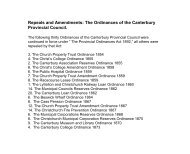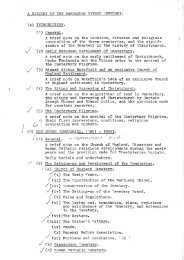Rich man, poor man, environmentalist, thief - Christchurch City ...
Rich man, poor man, environmentalist, thief - Christchurch City ...
Rich man, poor man, environmentalist, thief - Christchurch City ...
You also want an ePaper? Increase the reach of your titles
YUMPU automatically turns print PDFs into web optimized ePapers that Google loves.
and putting on display a hu<strong>man</strong> skeleton which was found at<br />
the site.<br />
Frederick’s major achievement was the discovery and<br />
identification of harpagornis, the New Zealand eagle. On<br />
Sunday 26 March 1871, at Glenmark, the taxidermist was<br />
supervising an excavation five to six feet below the swamp.<br />
There, over an area of 30 feet square and among a quantity of<br />
moa remains, were found, in an excellent state of preservation,<br />
a few smaller bones. These – a femur, rib and two claws –<br />
Frederick at once deduced to be from a giant bird which preyed<br />
on and died with a swamp-stuck moa. Some time later, further<br />
bones from the same skeleton were discovered.<br />
Newspapers – practical organs giving voice to work-a-day issues<br />
– made passing reference to the discovery. However, Haast wrote<br />
it up in an article in the Transactions of the New Zealand Institute.<br />
Fearing that a vessel might be lost on the voyage to England, the<br />
museum director stated that he would depart from the practice<br />
of sending the bones to an overseas anatomical expert. Instead,<br />
he would honour the Glenmark landowner by calling the bird<br />
harpagornis moorei and have Frederick Fuller articulate his find.<br />
Haast, impressed with the enormous strength of the<br />
feathered moa hunter, commented that, of contemporary<br />
carnivorous mammals, only the lion and tiger possessed<br />
stronger claw bones. Research has shown that harpagornis<br />
dwelt in the South Island’s shrub land and forest. It scooped<br />
up unsuspecting geese, and struck down 250 kilogram adult<br />
moa, the tallest bird ever to have existed. Not only was<br />
harpagornis the top carnivore in the early New Zealand food<br />
chain, it was also the world’s largest eagle and the largest bird<br />
of prey, bigger even than its cousins, the Philippine eagle and<br />
Andean condor. He reigned supreme for thousands of years<br />
prior to the coming of the Maori. In vestigial Polynesian legend<br />
he was ‘te hokioi’, the name being based on his cry, ‘Hokioi,<br />
hokioi, hu’, which was feared as a portent of war. However,<br />
he lacked adaptability, becoming extinct a few centuries after<br />
<strong>man</strong>’s arrival when the common food supply, the moa, was<br />
wiped out.<br />
Frederick Fuller was a family <strong>man</strong>. Children were born to<br />
Mary and Frederick in South Australia, Otago and<br />
<strong>Christchurch</strong>; eventually there were five sons and two<br />
daughters. Some of the children – Frederick and John, for<br />
example – were baptised in both Catholic and Anglican<br />
churches. However, after settling in Avonside, the family<br />
became associated with Holy Trinity Anglican church. John,<br />
Thomas and Mary were baptised there in 1869, followed two<br />
years later by Sarah.<br />
Although but a skilled servant, Frederick moved easily<br />
among the intellectuals of the colonial gentry. Haast often<br />
acknowledged his technical skill and immense loyalty. Early<br />
on he stated: ‘We could not find a more hardworking or useful<br />
<strong>man</strong> than Mr Fuller who has hitherto performed his duties to<br />
everybody’s satisfaction’. He informed his superiors: ‘I cannot<br />
dismiss Mr Fuller who has worked day and night<br />
indefatiguably [sic]…’ Much later he mentioned the<br />
taxidermist’s ‘perseverance... assiduity... [and] real<br />
enthusiasm’; and how ‘Mr F R Fuller... has continued to<br />
labour with the same energy as for years past’.<br />
Alas, Frederick was subject to depression and over-fond of<br />
alcohol; a son was to state that he got intoxicated once or<br />
twice a week. He drank on the job and, eventually, in July<br />
1876, the usually kind-hearted Haast fired him. Seeking an<br />
investigation into the causes of his dismissal, Frederick<br />
addressed a mildly worded ‘appeal to the public of<br />
<strong>Christchurch</strong>’ but the newspapers refused to publish it. In ‘a<br />
low state of mind’ the unfortunate <strong>man</strong> entered the workshop<br />
behind his home and there consumed arsenic which he had<br />
used in his employment. An unco-operative patient, he<br />
frustrated a doctor’s attempts to pump the poison from his<br />
body. On 28 July he died.<br />
Frederick left ‘a wife and five young children very <strong>poor</strong>ly<br />
provided for’. By five votes to four and with the chair<strong>man</strong><br />
abstaining, the Canterbury College Board of Governors<br />
carried a motion that Mary should be granted two months of<br />
her husband’s salary. It was necessary that the amount be<br />
Harpagornis atop a slain moa.<br />
From <strong>Rich</strong>ard Holdaway’s Terror of the forests, New<br />
Zealand geographic, October/December 1989,<br />
p56<br />
19

















